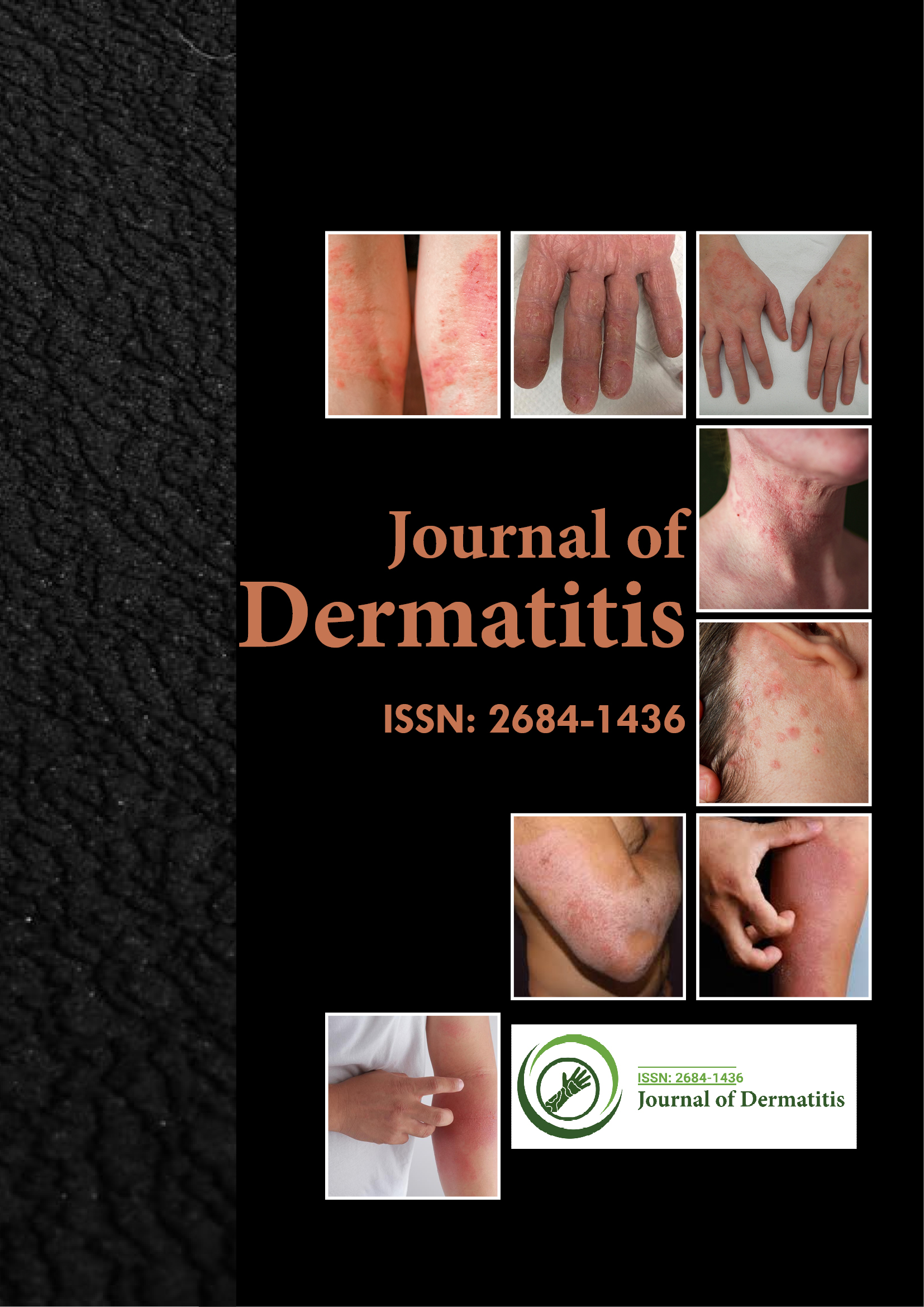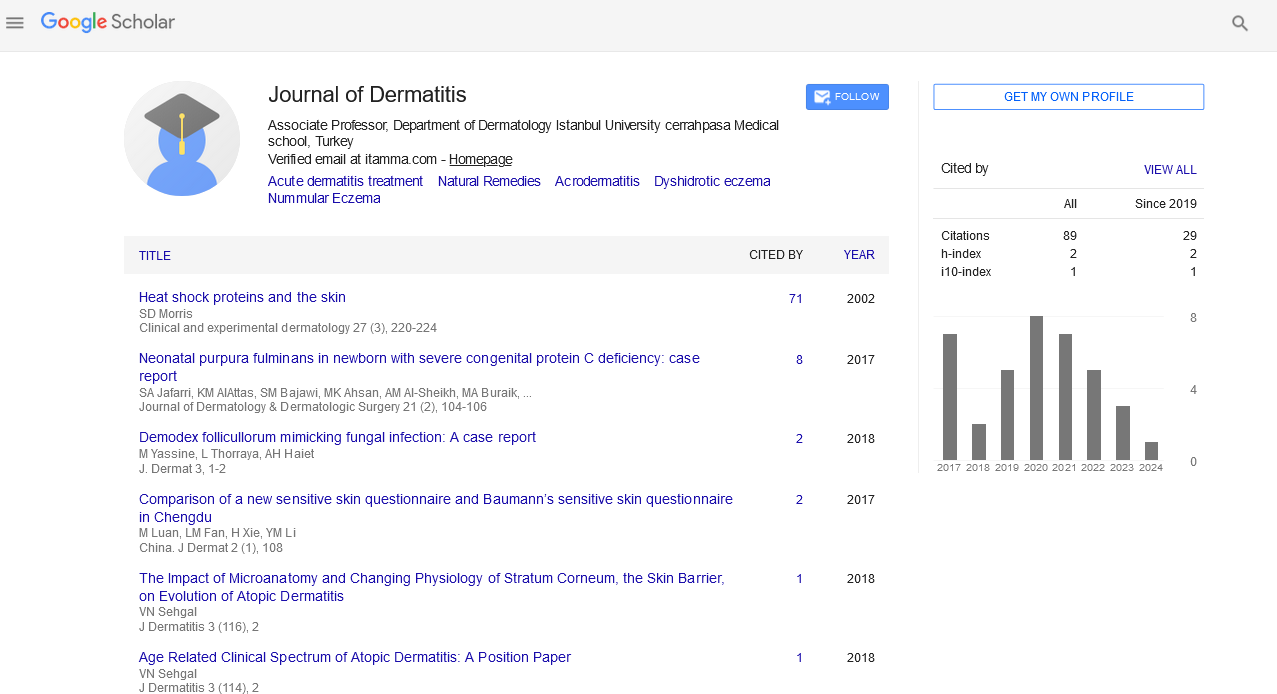Indexed In
- RefSeek
- Hamdard University
- EBSCO A-Z
- Euro Pub
- Google Scholar
Useful Links
Share This Page
Journal Flyer

Open Access Journals
- Agri and Aquaculture
- Biochemistry
- Bioinformatics & Systems Biology
- Business & Management
- Chemistry
- Clinical Sciences
- Engineering
- Food & Nutrition
- General Science
- Genetics & Molecular Biology
- Immunology & Microbiology
- Medical Sciences
- Neuroscience & Psychology
- Nursing & Health Care
- Pharmaceutical Sciences
Commentary - (2023) Volume 8, Issue 1
Perioral Dermatitis: Management and Treatment
Guimera Paz*Received: 02-Jan-2023, Manuscript No. JOD-23-19861; Editor assigned: 04-Jan-2023, Pre QC No. JOD-23-19861(PQ); Reviewed: 18-Jan-2023, QC No. JOD-23-19861; Revised: 25-Jan-2023, Manuscript No. JOD-23-19861 (R); Published: 01-Feb-2023, DOI: 10.35248/2684-1436.23.08.174
Description
Perioral dermatitis is a benign eruption that most frequently affects young, female adults. It has pink, scaly areas around the mouth or tiny, inflamed papules and pustules. The perioral region is where the disease is most frequently found, however it can also affect the particular and paranasal skin. It is frequently referred to as periorificial dermatitis because of this. This may be brought on by topical steroid use on the face, so the patient should stop applying steroid creams as the first line of treatment. Topical metronidazole, topical calcineurin inhibitors, and oral tetracycline antibiotics are further therapeutic options. Although perioral dermatitis frequently responds well to treatment, it can also be persistent and recurrent.
Perioral dermatitis has an unknown specific aetiology. Its aetiology has been connected to numerous environmental exposures. There is a link between the use of topical corticosteroids and perioral dermatitis in some people. The use of topical steroids may be used prior to the eruption, and longterm usage of these drugs raises the risk of developing serious illness. The topical steroid is initially effective in treating the face eruption. However, the eruption returns after stopping the topical steroid. This results in a dependency on topical steroids over time. Chronic steroid use may eventually cause perioral dermatitis to worsen and develop into a granulomatous subtype of the condition.
Perioral dermatitis has been linked to the usage of nasal and inhaled corticosteroids in addition to topical steroid use. Unknown is the precise mechanism by which topical steroids predispose people to perioral dermatitis. Topical steroids are thought to affect the microflora of hair follicles, which may aid in the aetiology of this illness. Some researchers have suggested Candida albicans, fusiform bacteria, and Demodex mites as infectious causes that may contribute to perioral dermatitis. Perioral dermatitis has also been linked to using fluoridated toothpaste.
Furthermore, perioral dermatitis has been linked to both chewing gum and dental fillings. Some patients have reported that the use of physical sunscreens and moisturizers in combination, as well as other cosmetic products, was the cause of their condition. Hormonal considerations have been taken into account in the aetiology of this ailment given the prevalence of females with it. It's interesting to note that perioral dermatitis has been shown to improve with the use of oral contraceptives.
Treatment and management
Metronidazole cream or gel, clindamycin lotion or gel, erythromycin gel, topical sulphur formulations, and azelaic acid gel are among the first-line treatments for perioral dermatitis. Because they have anti-inflammatory characteristics, antibiotics are useful in the treatment of this illness. Additionally beneficial are topical calcineurin inhibitors such tacrolimus ointment or pimecrolimus lotion. Topical adapalene and formulations containing sulphur or sulfacetamide have been shown to offer improvement. It has been observed that photodynamic therapy utilizing 5-aminolevulinic acid as a photosensitizer is beneficial. Oral antibiotics are frequently beneficial when topical medications are ineffective or the perioral dermatitis has a significant degree of involvement. For an 8–12 week tapering course, tetracycline 250 mg–500 mg twice daily, doxycycline 100 mg twice daily or once daily, and minocycline 100 mg twice daily or once daily can be administered. Tetracycline antibiotics can be substituted with erythromycin 250 mg to 500 mg daily when they are contraindicated, such as in infants younger than 8 years old and pregnant women. Although topical treatments should be used in conjunction with oral antibiotic therapy, its purpose is to produce quick improvement.
The goal is to quit oral antibiotics if at all possible after 3 months because topical treatments might not reach their maximal efficacy until 3 months of daily use. However, some individuals could need lengthier courses of oral antibiotics if chronic daily topical treatments are unable to control them. Low-dose oral isotretinoin, initially administered at 0.2 mg/kg per day and gradually tapered to 0.1 mg/kg to 0.05 mg/kg per day, may be utilized in resistant and severe cases. It is crucial to understand that topical corticosteroids shouldn't be applied to perioral dermatitis because it is not a basic eczematous condition. Although topical corticosteroids may have a shortterm beneficial effect, when they are stopped, the rash frequently flares up and gets worse. Patients should be informed that their condition is likely to get worse before getting better once the proper perioral dermatitis treatments are started if they have been taking topical corticosteroids to treat the eruption. Abrupt withdrawal of these medications might cause rebound flare. It may be necessary to gradually wean a patient off a medium to high potency steroid by utilizing a low potency steroid, such as hydrocortisone cream.
Citation: Paz G (2023) Perioral Dermatitis: Management and Treatment. J Dermatitis.8:174.
Copyright: © 2023 Paz G. This is an open-access article distributed under the terms of the Creative Commons Attribution License, which permits unrestricted use, distribution, and reproduction in any medium, provided the original author and source are credited.

